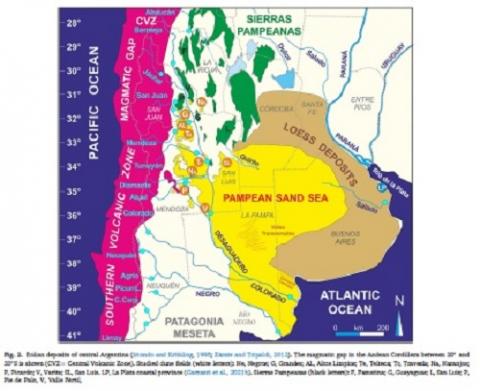Eduardo Garzanti, Tomas Capaldi, Alfonsina Tripaldi, Marcelo Zarate, Mara Limonta, Giovanni Vezzoli
2 022
Earth-Science Reviews Volume 231, August 2022
We here review in terms of tectono-magmatic setting and Quaternary landscape dynamics what is known about
the provenance of Argentine dune fields and their fluvial feeder systems draining the Andean Cordillera. The
detrital signatures of these eolian sediments were previously investigated based on either framework petrography and heavy minerals or detrital-zircon geochronology, and their peculiar volcaniclastic nature was long
recognized. Compositional variability, however, was only broadly evaluated, and quantitative provenance
analysis based on a systematic multimethod approach across the entire region was not carried out so far. For this
reason, here we integrate original and previously obtained petrographic, heavy-mineral, and detrital-zircon
geochronology data to present the first comprehensive provenance study of dune fields stretching for 1000
km across central Argentina from the Andean piedmont to the Atlantic Ocean.
In dune fields along the Andean retroarc basin, sediment composition defines a steady northward decrease in
volcanic detritus. This reflects active magmatism in the Southern Volcanic Zone and Payenia province (38◦-
34◦S), in contrast with the ~600-km-long Pliocene-Quaternary magmatic gap in the Pampean flat-slab segment
(33◦-27◦S), where sediment is derived from deeper-seated tectono-stratigraphic levels of the continental arc and
uplifted blocks of retroarc-basin basement. In distal Pampean lowlands extending across the bulge and backbulge
depozones, instead, sand dunes display notably homogeneous compositional signatures, indicating that detritus
was mostly generated north of 34◦S and transported by a paleo-Desaguadero trunk river that formed during
southward-progressing diachronous uplift of the Sierras Pampeanas since the late Miocene. In contrast with huge
African and Arabian deserts that contain multiply recycled quartzose to pure quartzose sand, even very fragile
volcanic clasts, plagioclase feldspar, and unstable ferromagnesian minerals are widespread, testifying to largely
first-cycle volcanic provenance and only minor effects of mechanical breakdown and chemical weathering in the
Pampean Sand Sea.
During the Late Pleistocene, after a first southward shift of the Desaguadero trunk river possibly induced by
increased water and sediment discharge at the end of the penultimate glacial maximum, tectonic uplift eventually outpaced stream power during the last glacial period. Paleo-rivers were thus forced to shift farther
southwards, leading to the formation of an integrated paleo-Desaguadero+Colorado drainage system. During the
latest Pleistocene-early Holocene, such a large trunk river fostered the rapid progradation of a wide delta and
littoral sand transport all along the shores of the Buenos Aires Province. Climate change and repeated waxing and
waning of glaciers through the Quaternary have left a prominent mark on sediment distribution, dominated by
fluvial processes during periods of high fluvial discharge but alternating with arid phases characterized by
limited transport capacity and vegetation cover, extensive wind deflation of floodplains, and sand accumulation
in the dune fields.
the provenance of Argentine dune fields and their fluvial feeder systems draining the Andean Cordillera. The
detrital signatures of these eolian sediments were previously investigated based on either framework petrography and heavy minerals or detrital-zircon geochronology, and their peculiar volcaniclastic nature was long
recognized. Compositional variability, however, was only broadly evaluated, and quantitative provenance
analysis based on a systematic multimethod approach across the entire region was not carried out so far. For this
reason, here we integrate original and previously obtained petrographic, heavy-mineral, and detrital-zircon
geochronology data to present the first comprehensive provenance study of dune fields stretching for 1000
km across central Argentina from the Andean piedmont to the Atlantic Ocean.
In dune fields along the Andean retroarc basin, sediment composition defines a steady northward decrease in
volcanic detritus. This reflects active magmatism in the Southern Volcanic Zone and Payenia province (38◦-
34◦S), in contrast with the ~600-km-long Pliocene-Quaternary magmatic gap in the Pampean flat-slab segment
(33◦-27◦S), where sediment is derived from deeper-seated tectono-stratigraphic levels of the continental arc and
uplifted blocks of retroarc-basin basement. In distal Pampean lowlands extending across the bulge and backbulge
depozones, instead, sand dunes display notably homogeneous compositional signatures, indicating that detritus
was mostly generated north of 34◦S and transported by a paleo-Desaguadero trunk river that formed during
southward-progressing diachronous uplift of the Sierras Pampeanas since the late Miocene. In contrast with huge
African and Arabian deserts that contain multiply recycled quartzose to pure quartzose sand, even very fragile
volcanic clasts, plagioclase feldspar, and unstable ferromagnesian minerals are widespread, testifying to largely
first-cycle volcanic provenance and only minor effects of mechanical breakdown and chemical weathering in the
Pampean Sand Sea.
During the Late Pleistocene, after a first southward shift of the Desaguadero trunk river possibly induced by
increased water and sediment discharge at the end of the penultimate glacial maximum, tectonic uplift eventually outpaced stream power during the last glacial period. Paleo-rivers were thus forced to shift farther
southwards, leading to the formation of an integrated paleo-Desaguadero+Colorado drainage system. During the
latest Pleistocene-early Holocene, such a large trunk river fostered the rapid progradation of a wide delta and
littoral sand transport all along the shores of the Buenos Aires Province. Climate change and repeated waxing and
waning of glaciers through the Quaternary have left a prominent mark on sediment distribution, dominated by
fluvial processes during periods of high fluvial discharge but alternating with arid phases characterized by
limited transport capacity and vegetation cover, extensive wind deflation of floodplains, and sand accumulation
in the dune fields.

